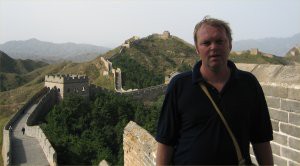 |
China has always been near the top of my list of places to see and to stand on the great wall would be one of the greatest achievements of my life.I was told the country was in transition and about to change forever. I didn’t want the same thing as happened in Prague, so I booked with Emirates and off I went. |
| I arrived at the Red Wall hotel at 11pm and immediately setup my laptop.The room had fast (well fast for China) internet connectivity so I was able to keep in touch with my friends and upload my digital pictures each night.The room was spotlessly clean, but in every other respect the hotel was awful, and prompted me to write a letter of complaint.
This is what I look like after 22 hours of travelling !. |
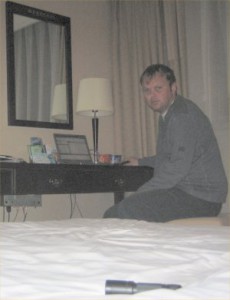 |
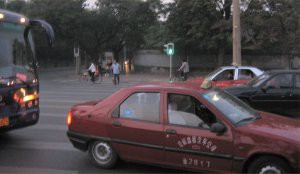 |
The following day I decided to go out exploring.The first things I noticed, was that the crossing light’s in Beijing are largely for show, and nobody takes any notice of them.The trick, is to wait until a local crosses, and match them step for step, across the road. Its also important to look inconspicuous, otherwise you will be accused of stalking :). |
| Although there are some spectacular buildings and stuff like that in Beijing, small alleyways called Hutongs are the place where most of the interesting stuff is (after all, a department store, is a department store, anywhere in the world, I was looking for the essence of China).Small close knit communities exist in these alley ways, a camaraderie and a help/protect one another attitude, which my Grandma used to speak of in England exists here. |
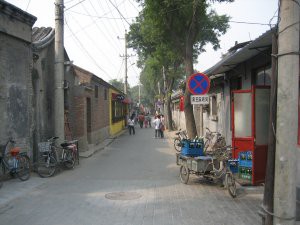 |
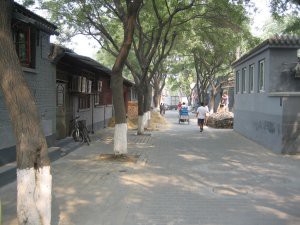 |
Its quite amazing, that entire societies exist just a few yards from the main roads.The most authentic shops and restaurants are in these alleyways.You can see from this picture, that someone has painted the tree’s white, to avoid accidents at night (there are no street lights here, and most people travel by bicycle !). |
| As I followed a few wandering people, I came to this small park.It was obviously the place where the locals go to relax (and these were after all, the people I travelled here to find out about).People stood chatting, a few played cards, and there was the usual throng of Thai Chi practitioners. |
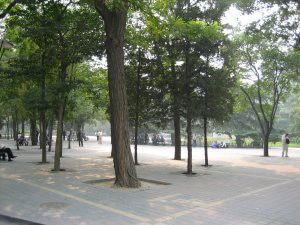 |
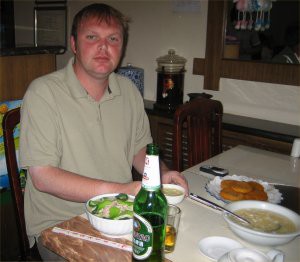 |
I enjoyed an evening meal, in a family run Hutong Tea House.The whole family were sat mesmerized by the soap opera , which featured a very famous chinese actor they all seemed to like.Once I ordered, the whole family seemed to leap into action, and served me the 3 course meal you can see here, including beer, for £1.50.
The food was superb, although I decided to pass on fried Bee’s !. |
| Across the street from the restaurant, just to the left of this picture, was a public lavatory.I watched with amazement as an elderly couple, waked across the Hutong in their pyjamas, carrying towels and toothbrushes.I learned from the owner of the cafe that many homes, don’t actually have toilets or running water, and people use the public lavatory as a bathroom. |
 |
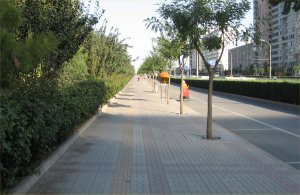 |
Although public transport was pretty good in Beijing, I have always enjoyed walking and decided to go out for a long walk.You can see from this picture, how long some of the streets are in Beijing. |
| I decided to Visit the military museum as recommended by the rough guide.There were lots of School trips, and outside, children queued to stand on the deck of a Navy missile launcher. |
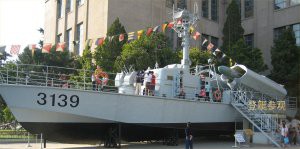 |
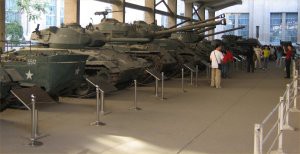 |
The museum held the largest collection of military ordinance I had ever seen.The tanks and other vehicles were from all over the world (including Britain) they had the same model of tank I had seen outside reunification hall in Saigon. |
| The Museum showed the real iron fist of communism.This spectacular room, is filled with Jets and Tanks, and in the centre a decommissioned nuclear missile. |
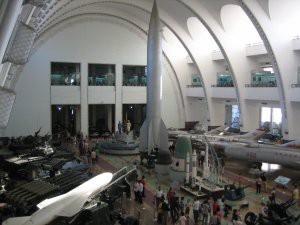 |
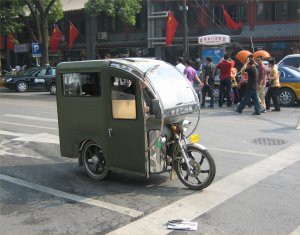 |
Its amazing to see how some cultures solve problems common to the whole world.In the UK, if a person suffers from mobility problems, they are normally given a car, retired from work and paid an allowance.In China, a person is issued with one of these vehicles (a kind of one person taxi) and he/she can earn their own living.
Equally, homeless people and the very poor, are paid a small bounty for plastic bottles, aluminium cans and other rubbish.
By making these things a commodity street rubbish is virtually non existent. On one day, I walked for 19 miles, and I didn’t see a single can or bottle. |
| When I was a youngster, me and mum used to watch Blue Peter.I remember we watched it, when the famous Chinese Panda’s were on it.I decided to visit Beijing Zoo and see them first hand.
I had read criticisms of the Zoo, but I found it to be superb. |
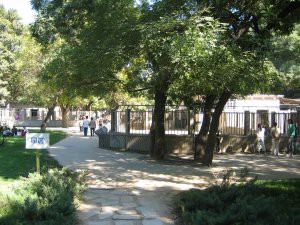 |
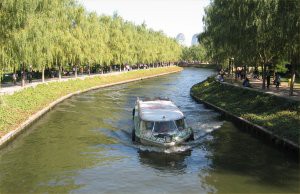 |
One exhibit that surprised me, was an enclosure for Alsatian Dogs, which I have never seen in a Western Zoo.A river runs through the centre of the Zoo, and its possible to take a boat tour.It was near here, that I tried to find the Panda enclosure. As nobody spoke English, I removed a soft toy Panda I had purchased as a gift, and started to waive it around to attract attention.
They dismissed me, and I realized they thought I was trying to sell it to them. I found 2 Americans, who were able to help. |
| China has exported Panda’s to Zoos all over the world. They are considered a symbol of pride and a national treasure in that country.Considering they weren’t actually in the wild, I was delighted to see how happy and playful they were.Each of the Panda’s has an enormous enclosure, and I was extremely lucky to get this picture, just before the Panda got out of the chair. |
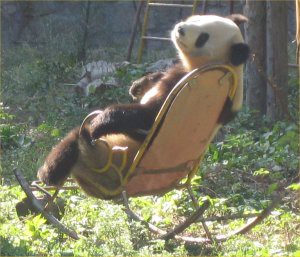 |
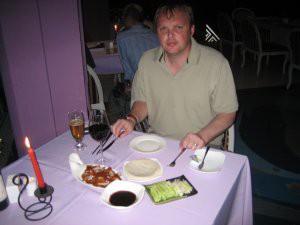 |
Its said the 2 things to do when visiting Beijing, are stand on the Great Wall, and eat Beijing Duck.Considering I was going to eat such a delicacy, I took some time and chose an appropriate restaurant. The food was superb.One thing I especially liked about Beijing was the delight people showed, when they received a tip.
My £1 tip, was treated with the elation of a marriage proposal 🙂 |
| I visited the Tiantan Park, to see the Temple of heaven.I was glad I had chosen 8 days for my trip, as it meant I could spend the whole day here.It was one of the most amazing sight’s in Beijing.
Although this picture doesn’t capture its splendour very well, I was trying to show the scale, like most things in Beijing, is massive. |
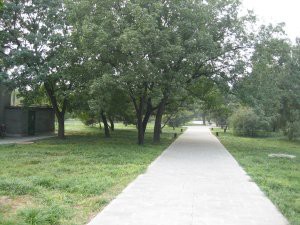 |
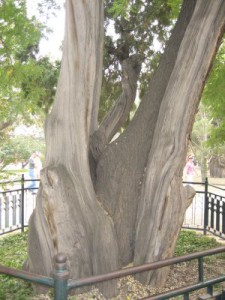 |
The Brother Trees – a Cypress tree embracing a Pagoda tree in the par.Both trees are symbols of Beijing and are seen as a symbol of friendship and brotherhood, among the Beijing people |
| The Temple of heaven.Because I had visited on a working day, it was a lot quieter than normal.Everything about the temple relates to numbers and its alignment with energy.
The 3 dome shaped roofs, symbolize Heaven, Earth and Man. |
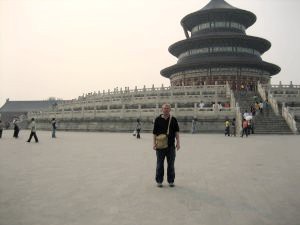 |
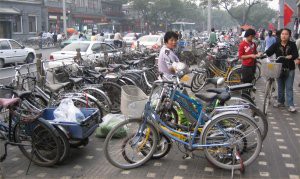 |
I had expected to see many thousands of bicycles in Beijing, but the scale beggared belief.I had the option to rent one and ride around, but I decided instead to walk, as I find it more relaxing, and I was after all, on holiday. |
| Yonghe Gong.Bold and Brash, the largest Buddhist temple in Beijing, built in the 1700’s.It was closed for 30 years, and was lucky to escape destruction during the communist revolution.
Not massively authentic, most of the monks here are pro government.
It was here that China’s choice for the Panchen Lama (2nd only to the Dalai Lama) was sworn in, in 1995.
Just prior to this, the Dalai Lama’s own choice 6 year old Gedhum Choekyi Nyima “disappeared”.
He remains the worlds youngest political prisoner. |
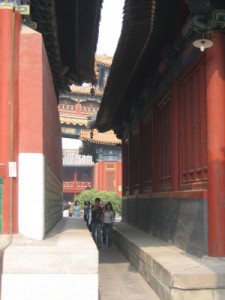 |
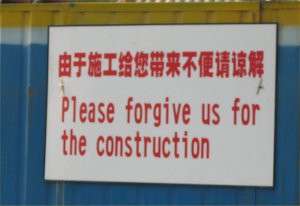 |
My first sighting of “chinglish” (short for Chinese English) while walking around the temple.The problem is, some Chinese people learn English and then translate it literally. This can have hilarious consequences, when these fraises are put onto street signs.A sign saying “please don’t disrespect the grass” was my favorite of the whole trip. |
| Near the Wavu Pavilion, which features an 18 meter high wooden Buddha carved from one Sandlewood tree.It took 3 years just to transport it from Tibet. For reasons not explained, we weren’t allowed to photograph it.Trust me, I have carved spoons, and this thing was spectacular !. |
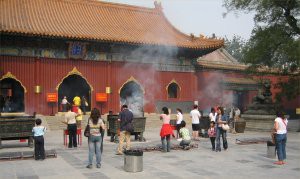 |
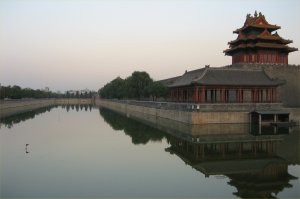 |
Forbidden City also known as the Gugon or Imperial Palace.I took this picture, from across the moat just before dusk. |
| The formidable outer wall.The city was built in the 1500’s and for 5 centuries was the home of 24 ming and quang emperors.Ordinary chinese were forbidden from even approaching its outer walls, hence its name. |
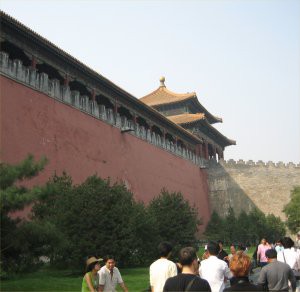 |
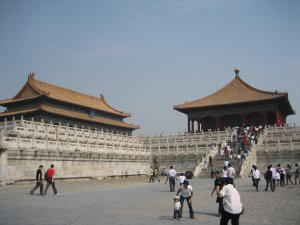 |
The Large courtyard where the emperor would address his courtiers.100,000 people would sit here, at the Emperors pleasure.It’s next to the chambers which hold the 11,099 volume encyclopaedia commissioned by Yongle. |
| A rare occasion when I found someone who spoke English and got them to photograph me.I originally thought the Chinese, quite impolite, as they constantly pushed in.I realized from my guide book, that in a city this size, “British” style queuing just doesn’t exist.
When I started to push in myself (which felt quite uncomfortable at first) I found the people I “bumped” didn’t seem to mind. |
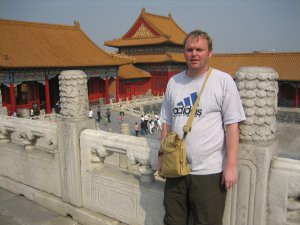 |
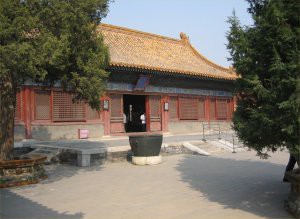 |
This was the home of a concubine, with its own courtyard. Her servants and guards would live in buildings nearby.The large iron bowl outside the door, was used for storing water, in the event of a fire.During winter, quilts would be used to keep the water from freezing. |
| The Forbidden city has Eight hundred buildings and nine thousand chambers.They are mostly connected through chambers and corridors like this one.Its normally difficult to take a picture at a popular tourist site, without getting some people in the picture somewhere.
Here, it was so busy, it was difficult to take a picture without getting a photographer in it. |
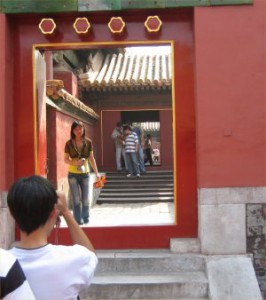 |
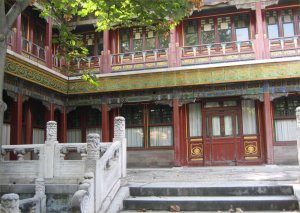 |
A house that belongs to one of the emperors advisers.Much more elaborate than the residence of the concubine.Residences like this one, next to the imperial garden, were much sought after by courtiers. |